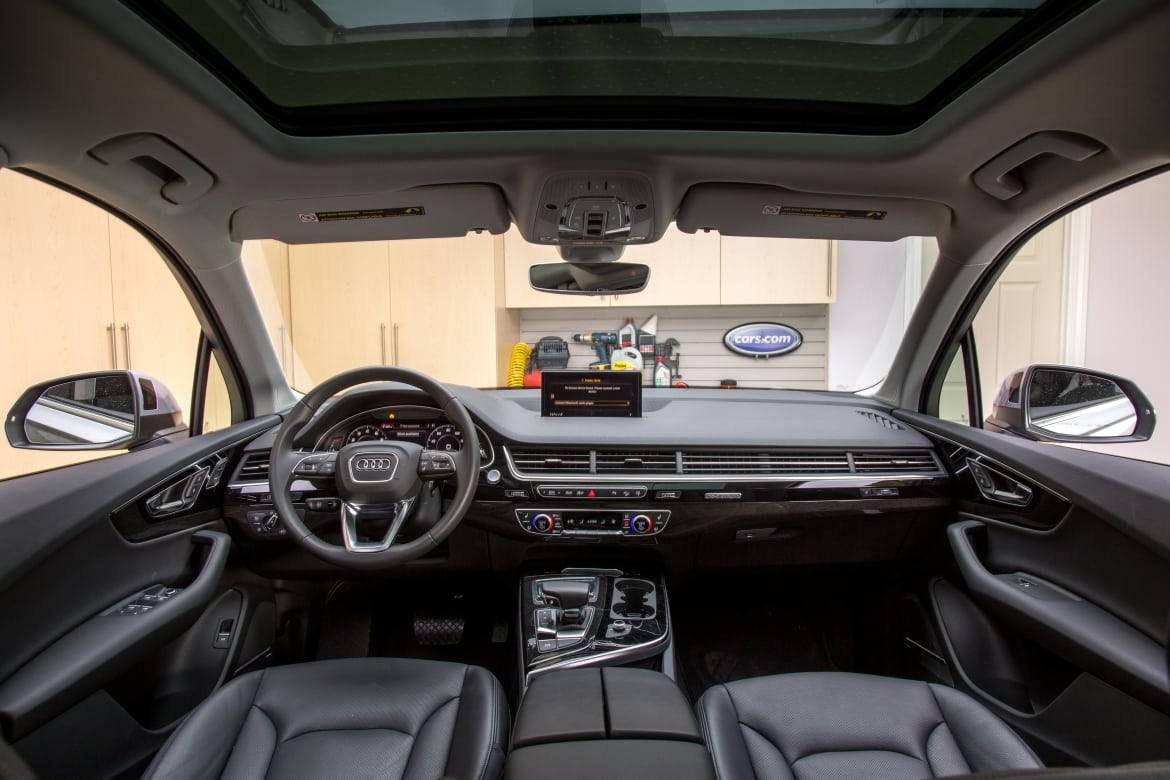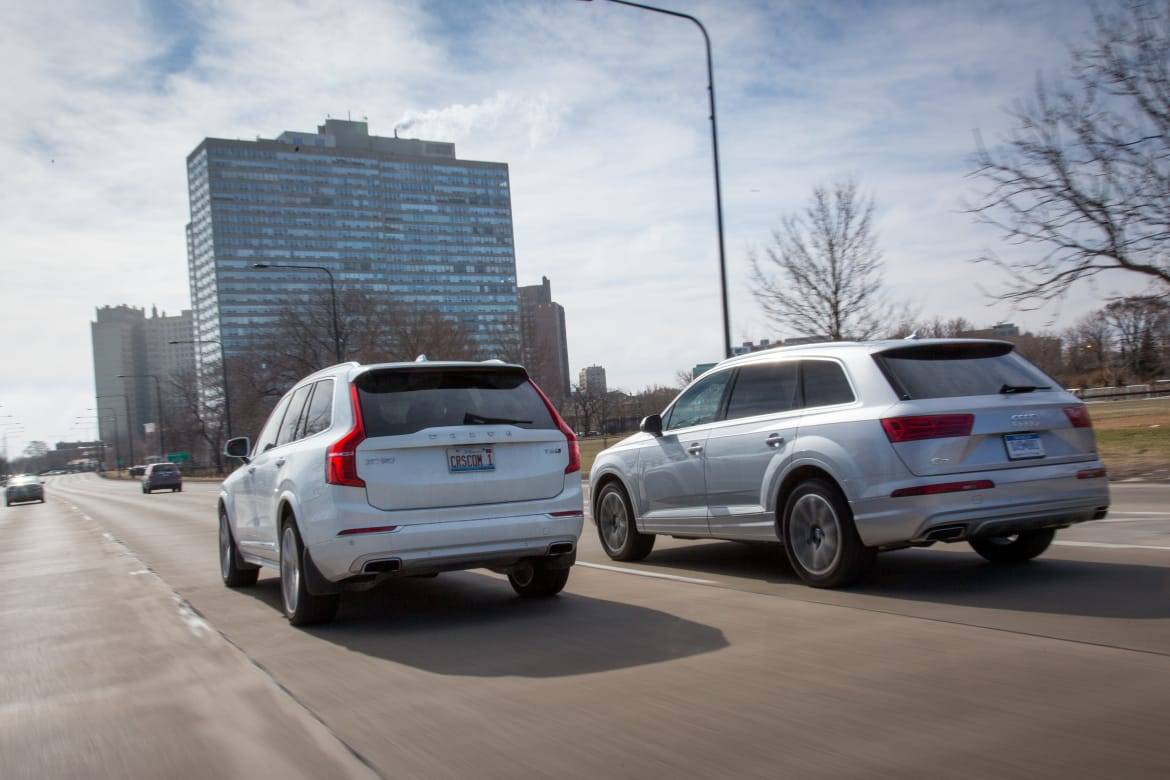Volvo XC90 Versus Audi Q7: Luxury SUVs Go Head-to-Head

CARS.COM — The Audi Q7 and Volvo XC90 went without redesigns for an automotive eternity: nine and 12 model years, respectively. If cars were houseguests, these SUVs were the in-laws that dragged Christmas vacation into February.
Related: Follow Our Long-Term Fleet
Both redesigns finally showed up. Cars.com awarded the stunning second-generation 2016 XC90 its highest honor of the year, and Audi followed a few months later with an overhauled 2017 Audi Q7. We pitted our long-term XC90 against a Q7 in a head-to-head comparison.
What’s remarkable is how evenly these test vehicles were matched: Both seat seven in three rows of seats, both offer all manner of assistive safety technology and both have all-wheel drive and forced-induction engines. In the end, even their as-tested prices fell a stone’s throw from each other: $66,265 for our long-term all-wheel-drive 2016 Volvo XC90 T6 Inscription and $68,925 for the 2017 Audi Q7 3.0T Premium Plus Quattro.
How did they compare? Below we call out and grade the competitors on the differences that proved most meaningful. We don’t address differences that were slight (cargo space is one example).
Interior Quality

Winner: Volvo XC90
The XC90 has this one, clearly. Volvo’s optional Nappa leather feels richer than the Q7’s standard leather, and it also covers the dash and upper doors to premium effect. The Volvo’s design and materials are more cohesive. The Q7 has a lot more visual clutter, and it also demonstrates Audi’s habit of using cheaper finishes on lower sections of the center console and doors — areas where the Volvo XC90 doesn’t drop the ball.
First- and Second-Row Comfort

Winner: Audi Q7
If you value a softer driver’s seat, or additional adjustability like bottom cushion length or backrest side bolsters, you might prefer our Volvo, but we lean toward the Audi overall. Despite having fewer adjustments as equipped, its front seats are firm and comfortable, and there’s more room for all occupants where it matters most — primarily legroom in the front and second-row seats. The second row also seems to sit a bit higher for better thigh support. As equipped, the Q7 also had heated outboard seats and two automatic climate zones.
Third-Row Access and Comfort

Winner: Volvo XC90
Neither third row is adult-friendly; sliding the second-row seats forward can improve third-row legroom in both models, but adult passengers would still find their knees armpit-high, like they’re sitting on a Squatty Potty (Google it). Because the legroom in both vehicles limits their use to smaller humans, the Q7’s slightly greater headroom is almost irrelevant. Its seat also is a bit higher off the floor than the XC90’s, which could provide a bit more comfort — but so could the third-row air vents on the Volvo’s C-pillars. What distinguishes the XC90 more significantly, though, is a proper sliding second row to provide access, where the Q7 makes you fold and tumble the second-row seats in a multistep process in order to reach the rear row like it’s 1995 all over again.
Visibility
Winner: Volvo XC90
Outward visibility is good in both models, but the XC90 improves the view to the rear with second- and third-row head restraints that fold forward to minimize obstructions further; the second row head restraints can even be folded with a dashboard control. To achieve the same in the Audi would require head restraint removal or folded backrests.
Controls and Multimedia
Winner: Volvo XC90
The XC90’s tablet-sized touch-screen is the right way to execute a system that dares to eliminate almost all mechanical buttons. The menus are mostly clear and easy to navigate, and the screen reacts quickly to touch. The Q7 brings a version of Audi’s Multi Media Interface that teams a new-generation structure with an ambitious interface featuring an oversized touchpad along with the usual knob. The result is more confusing and cumbersome to use than earlier versions, which we’ve praised. The Q7 also highlights, in clunky fashion, that Apple CarPlay and Android Auto are meant to be operated via touch-screen, not a knob. Android Auto’s Google map didn’t even fill the screen, appearing letterboxed on the sides. The Q7’s virtual cockpit instrument panel display behind the steering wheel is neat, but it did little to impress us in practice.
Acceleration

Winner: Audi Q7
Both of these are quicker than they need to be, but the Audi Q7 is quicker. More torque and horsepower from the Audi’s supercharged 3.0-liter V-6 is enough to compensate for the Q7’s greater weight, and we found it to have less hesitation than the XC90, whose drivetrain is reasonably responsive overall but balked more than the Q7 did. The Volvo’s engine — a 2.0-liter four-cylinder that’s both supercharged and turbocharged — is remarkable in its own right, but it has less off-the-line torque and was considerably noisier.
Ride
Winner: Volvo XC90
You can’t beat the XC90’s air suspension and adaptive shock absorbers for softness and comfort, but it didn’t run away with this category. Though Audi offers an adaptive suspension, our Q7 didn’t have it, and the standard suspension truly impressed — especially because we’ve driven the XC90’s standard suspension, and it’s way too firm.
Handling

Winner: Audi Q7
If you’re looking for sporty driving, these two aren’t the place to start. But there are differences, and we preferred the Q7, which had quicker steering with better feedback. The XC90 felt soupier, and the lag mentioned above frustrates attempts to accelerate out of a corner. Its advanced suspension is a one-trick pony, whose trick is comfort. The Dynamic mode does little for its agility apart from quelling body roll a bit. The XC90 is almost 550 pounds lighter than the Q7, but it doesn’t feel like it.
Worth the Money?
Winner: Volvo XC90
For nearly the same price, the Q7 had a few extra features, like a power-folding third row and a heated steering wheel and rear seats, but our XC90’s optional equipment — like the advanced suspension — was of greater consequence. Perhaps most importantly, its interior quality is superior, and not by just a little.
Results

This is an anticlimactic declaration, certainly, as we deemed the Volvo XC90 winner in six of nine categories. Granted, the Audi Q7’s win in first- and second-row comfort is important in an SUV of this type, but its other triumphs were for acceleration and handling, which aren’t as critical in a luxury family hauler as they would be in, say, a sport sedan. The Volvo’s performance in these areas was certainly good enough. The 2017 Q7 wasn’t out yet when we deemed the XC90 our Best of 2016, and though the Audi is good, it hasn’t changed our enthusiasm for our winner.
Featured stories




